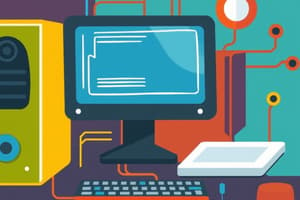Podcast
Questions and Answers
What are the two main classifications of computer hardware?
What are the two main classifications of computer hardware?
- Software and Firmware
- Primary and Secondary Storage
- Input and Output Devices
- Internal and External Hardware Devices (correct)
What is the main circuit board of a computer called?
What is the main circuit board of a computer called?
Motherboard
What is a CPU's primary role in a computer?
What is a CPU's primary role in a computer?
- Data Storage
- Processing Instructions (correct)
- Displaying Output
- Networking
RAM is a type of non-volatile memory.
RAM is a type of non-volatile memory.
What does HDD stand for?
What does HDD stand for?
Which of the following components is considered internal hardware?
Which of the following components is considered internal hardware?
What are the two broad classes of computer software?
What are the two broad classes of computer software?
A database is an organized collection of structured ______.
A database is an organized collection of structured ______.
What does 'peopleware' refer to?
What does 'peopleware' refer to?
Hardware and software can function effectively without each other.
Hardware and software can function effectively without each other.
What are leverage points in a complex system?
What are leverage points in a complex system?
Flashcards are hidden until you start studying
Study Notes
Basic Components of ICT
- Computer Hardware: Divided into Internal and External hardware.
- Internal Hardware Devices: Include components like the Motherboard, CPU, RAM, and Hard Disk Drive (HDD).
- Motherboard: The main circuit board connecting components; includes the CPU, RAM slots, and other ports.
- Central Processing Unit (CPU): The brain of the computer responsible for processing instructions; can have multiple cores (dual-core, quad-core).
- Random-Access Memory (RAM): Volatile memory storing data actively in use; capacity affects multitasking capability.
- Hard Disk Drive (HDD): Primary non-volatile storage device storing digital data, does not require power to retain stored information.
- External Hardware Devices/Peripherals: Input and output devices, such as keyboards, monitors, printers, and speakers.
Computer Software
- Definition: A general term for programs and applications that facilitate the function of hardware.
- Types of Software: Divided into system software (operating systems) and application software (specific user tasks).
- System Software: Manages hardware and provides user interface; crucial for the functionality of the system.
- Application Software: Designed for specific tasks, e.g., word processors and spreadsheets.
- Interdependence: Hardware and software are interconnected; both are necessary for effective operation of a computer system.
Telecommunications
- Definition: The transmission of information and signals over distances.
- Role: Provides the infrastructure for data, voice, and video exchange.
- Data: Raw facts processed or stored, can be various formats like text, images, or audio.
- Databases: Organized collections of structured data essential for efficient storage and retrieval.
Procedures in ICT
- Definition: Step-by-step guidelines for tasks related to technology; includes operational, security, data recovery, and maintenance procedures.
Peopleware
- Definition: The human aspect of ICT, comprising individuals and groups involved in technology management.
- Examples: Software developers, IT professionals, and project teams are all critical for technology efficacy.
Computer System
- Definition: A combination of hardware, software, and people facilitating data processing, storage, and retrieval.
- Characteristics:
- Interdependence: Components rely on each other to function effectively.
- Leverage Points: Small changes can lead to significant impacts within a system.
- Time Delay: Output may be impacted by predetermined delays in processing.
Conclusion
- Understanding the intricate relationship between hardware, software, procedures, and the human element is essential for effective information communication technology systems.
Studying That Suits You
Use AI to generate personalized quizzes and flashcards to suit your learning preferences.




